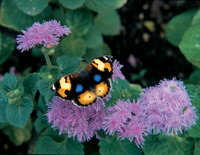A simple way to ‘do your bit’ for the environment
 With the loss of habitat and climate change having a major effect on our British butterflies, the Stratford Butterfly Farm is appealing for people to help halt the decline of these beautiful insects.
With the loss of habitat and climate change having a major effect on our British butterflies, the Stratford Butterfly Farm is appealing for people to help halt the decline of these beautiful insects. Creating a butterfly-friendly garden is one of the simplest ways in which people can make a difference and is both exciting and rewarding. With butterflies breeding from April – May; now is the time to create the perfect butterfly haven.
Firstly, locate the garden in a sunny area as butterflies and most butterfly attracting plants need bright sunshine. Butterflies wings are fragile so try to plan your garden around existing walls, hedges or trees which will act as wind breaks. Plant your garden to have continuous blossom throughout the season as butterflies are active from early spring until late autumn. In the spring choose from Aubretia, Grape Hyacinth, Primrose, Sweet Violet, Wallflower and Wood Anemone. In the summer grow Buddleia, Heather, Lavender, Lavatera and Verbena whilst in the autumn try planting Marigold, Honeysuckle, Sedum and Michaelmas Daisy.
Butterflies are attracted to certain colours and tend to prefer purple, pink and yellow coloured blossoms. Clusters of short, tubular flowers or flat topped blossoms provide the ideal shapes for butterflies to easily land on and feed. The nectar of single flowers is more accessible and easier for butterflies to extract that the nectar of double flowers which have many more petals. As well as using vision, butterflies also locate their favourite food sources by sense of smell. Planting aromatic plants such as rosemary, mint, chives, fennel, tarragon, basil and thyme is a good way of attracting them into your garden.
Include caterpillar host plants in your garden design. Caterpillars are selective feeders and will only eat specific kinds of plants. Usually the female butterflies lay eggs on or near the plants their caterpillars prefer to eat. If the desired food plants are not available, the butterflies will not egg lay or the caterpillars will starve rather than eat another type of leaf. Having the correct food plants will lure the female butterflies into your garden and provide food for their caterpillars.
Place flat stones in your garden as butterflies love to sit in the sun and often perch on stones, bare soil or vegetation to spread their wings and bask in the sun. Basking in the sun raises their body temperature so they are able to fly and remain active.
Use biological controls for pest management as most garden pesticides are toxic to butterflies and would poison them. Placing chippings around plants will help keep weeds down.
Finally relax, the best way to get good results for a butterfly garden is to relax and enjoy it. Don’t worry about the odd pest or patch of long grass. Some butterflies actually lay eggs on rough grass and stinging nettles are a very important host plant for many caterpillars so if you can, leave a patch of your garden to grow wild and undisturbed.
Visitors can pick up a leaflet from the Stratford Butterfly Farm about gardening for wildlife, especially with butterflies in mind. For more information on butterflies and their conservation, visit butterflyfarm.co.uk.

